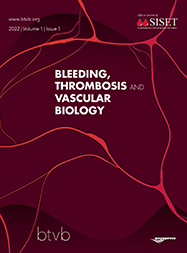Original Articles
Vol. 4 No. 3 (2025)
The landscape of rare coagulation factor deficiency management in Italy: a national hemophilia center survey

Publisher's note
All claims expressed in this article are solely those of the authors and do not necessarily represent those of their affiliated organizations, or those of the publisher, the editors and the reviewers. Any product that may be evaluated in this article or claim that may be made by its manufacturer is not guaranteed or endorsed by the publisher.
All claims expressed in this article are solely those of the authors and do not necessarily represent those of their affiliated organizations, or those of the publisher, the editors and the reviewers. Any product that may be evaluated in this article or claim that may be made by its manufacturer is not guaranteed or endorsed by the publisher.
Published: 5 November 2025
3
Views
5
Downloads
Similar Articles
- PO56 | Safety of anticoagulant treatment in patients with splanchnic vein thrombosis and history of portal hypertension-related bleeding , Bleeding, Thrombosis and Vascular Biology: Vol. 4 No. s1 (2025)
- PO38 | Rates of hemorrhagic events and hemodialysis circuit thrombosis in patients with end-stage renal disease on hemodialytic treatment receiving a factor-XI inhibitor: a systematic review and meta-analysis , Bleeding, Thrombosis and Vascular Biology: Vol. 4 No. s1 (2025)
- PO02 | Pregnancy and delivery in women with hemophilia and carriers are still challenging: a ten years analysis from The Italian Association of Hemophilia Centers (AICE) , Bleeding, Thrombosis and Vascular Biology: Vol. 4 No. s1 (2025)
- PO44 | Emicizumab in acquired haemophilia A , Bleeding, Thrombosis and Vascular Biology: Vol. 4 No. s1 (2025)
- CO36 | Inhibitor titer at diagnosis and clinical course in acquired hemophilia A: a single-center experience , Bleeding, Thrombosis and Vascular Biology: Vol. 4 No. s1 (2025)
- Augusto Di Castelnuovo, The evolution of hemostasis genetics: from monogenic disorders to complex traits. A historical perspective , Bleeding, Thrombosis and Vascular Biology: Vol. 4 No. 2 (2025)
- PO64 | A silent hemorrhage in the immuno-thrombotic chaos of antiphospholipid syndrome , Bleeding, Thrombosis and Vascular Biology: Vol. 4 No. s1 (2025)
- Luca Puccetti, Vincenzo Sammartano, Federico Caroni, Margherita Malchiodi, Paola Calzoni, Eleonora Franceschini, Lucrezia Galasso, Monica Bocchia, Safety of COVID-19 mRNA vaccination in patients with history of acquired hemophilia A: a case series , Bleeding, Thrombosis and Vascular Biology: Vol. 1 No. 3 (2022)
- CO33 | Acquired hemophilia A in Liguria, Italy: what six years of data reveal , Bleeding, Thrombosis and Vascular Biology: Vol. 4 No. s1 (2025)
- PO81 | Direct oral anticoagulants in atypical site vein thrombosis: a single centre experience focused on cancer patients , Bleeding, Thrombosis and Vascular Biology: Vol. 4 No. s1 (2025)
You may also start an advanced similarity search for this article.








